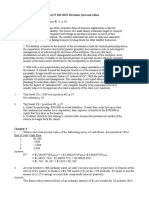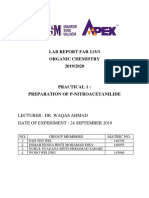ACF 103 - Fundamentals of Finance Tutorial 2 - Questions: Homework Problem
Uploaded by
Riri FahraniACF 103 - Fundamentals of Finance Tutorial 2 - Questions: Homework Problem
Uploaded by
Riri FahraniACF 103 – Fundamentals of Finance
Tutorial 2 - Questions
Chapter 3
1. What is the total present value of the following series of cash flows,
discounted at 10%?
End of year Cash flow
1 $1,000
2 1,000
3 -2,000
4 3,000
2. How long would it take for your money to triple if you invested it at 9%,
compounded annually?
3. At your brother's 15th birthday party, he asks you how much he would have to
deposit at the end of every month to finance a $4,250 motorcycle on his 18th
birthday. He plans to put the money in a 12% savings account that compounds
interest monthly.
Homework problem
4. Text book Ch 3 question # 9 (p.66)
5. Text book Ch 3 question # 12 (p.67)
6. Text book Ch 3 question # 13 (p.67)
7. It is January 1 and you have made a New Year's resolution to invest $2,000 in
an Individual Retirement Account (IRA) at the end of every year for the next
30 years. If your money is compounded at an average annual rate of 9%, how
much will you have accumulated at the end of 30 years?
8. Congratulations! You have just won first prize in a raffle and must choose
between $20,000 in cash today or an annuity of $5,000 a year for five years.
(The annuity payments would come to you at the end of each year.) Which of
these two choices is worth more, assuming a 7% discount rate? Show your
calculations.
9. Your aunt is bragging about the great investment she made in a house that she
bought 30 years ago for $20,000 and has just sold for $65,000.
a. Calculate the rate of return on this investment.
b. If the average annual rate of inflation has been 3.5% during this period,
was this "a great investment?" Explain.
10. Ms. Early Saver has decided to invest $1,000 at the end of each year for the
next 10 years, then she will just let the amount compound for 40 additional
years. Her brother, Late Saver, has a different investment program: He will
invest nothing for the next 10 years, but will invest $1,000 per year (at the end
of each year) for the following 40 years. If we assume an 8% rate of return,
compounded annually, which investment program will be worth more 50 years
from now?
ACF 103 Haut 2015 Tutorial 2 1
Homework problem
11. Text book Ch 3 question # 1 (p.65)
12 Text book Ch 3 question # 2 (p.66)
13. Text book Ch 3 question # 4 (p.66)
14. Text book Ch 3 question # 5 (p.66)
ACF 103 Haut 2015 Tutorial 2 2
You might also like
- The Subtle Art of Not Giving a F*ck: A Counterintuitive Approach to Living a Good LifeFrom EverandThe Subtle Art of Not Giving a F*ck: A Counterintuitive Approach to Living a Good Life4/5 (6124)
- The Gifts of Imperfection: Let Go of Who You Think You're Supposed to Be and Embrace Who You AreFrom EverandThe Gifts of Imperfection: Let Go of Who You Think You're Supposed to Be and Embrace Who You Are4/5 (1148)
- Never Split the Difference: Negotiating As If Your Life Depended On ItFrom EverandNever Split the Difference: Negotiating As If Your Life Depended On It4.5/5 (933)
- Hidden Figures: The American Dream and the Untold Story of the Black Women Mathematicians Who Helped Win the Space RaceFrom EverandHidden Figures: The American Dream and the Untold Story of the Black Women Mathematicians Who Helped Win the Space Race4/5 (954)
- The Hard Thing About Hard Things: Building a Business When There Are No Easy AnswersFrom EverandThe Hard Thing About Hard Things: Building a Business When There Are No Easy Answers4.5/5 (361)
- Laboratory Studies in Integrated Principles of Zoology 18th EditionNo ratings yetLaboratory Studies in Integrated Principles of Zoology 18th Edition54 pages
- The World Is Flat 3.0: A Brief History of the Twenty-first CenturyFrom EverandThe World Is Flat 3.0: A Brief History of the Twenty-first Century3.5/5 (2283)
- Devil in the Grove: Thurgood Marshall, the Groveland Boys, and the Dawn of a New AmericaFrom EverandDevil in the Grove: Thurgood Marshall, the Groveland Boys, and the Dawn of a New America4.5/5 (278)
- A Heartbreaking Work Of Staggering Genius: A Memoir Based on a True StoryFrom EverandA Heartbreaking Work Of Staggering Genius: A Memoir Based on a True Story3.5/5 (692)
- CH 10 PPT Examples Relaxing Credit Standards QnssolnsNo ratings yetCH 10 PPT Examples Relaxing Credit Standards Qnssolns8 pages
- Derivatives and Risk Management: Answers To Beginning-Of-Chapter QuestionsNo ratings yetDerivatives and Risk Management: Answers To Beginning-Of-Chapter Questions13 pages
- Introduction To Banking and Finance: Guy Hargreaves ACE-102No ratings yetIntroduction To Banking and Finance: Guy Hargreaves ACE-10225 pages
- ACF 103 - Fundamentals of Finance Tutorial 7 - SolutionsNo ratings yetACF 103 - Fundamentals of Finance Tutorial 7 - Solutions3 pages
- ACF 103 - Fundamentals of Finance Tutorial 10 - Questions: Homework ProblemNo ratings yetACF 103 - Fundamentals of Finance Tutorial 10 - Questions: Homework Problem3 pages
- ACF 103 - Fundamentals of Finance Tutorial 9 - QuestionsNo ratings yetACF 103 - Fundamentals of Finance Tutorial 9 - Questions2 pages
- ACF 103 - Fundamentals of Finance Tutorial 8 - Questions: Homework ProblemNo ratings yetACF 103 - Fundamentals of Finance Tutorial 8 - Questions: Homework Problem2 pages
- ACF 103 - Fundamentals of Finance Tutorial 4 - Questions: Homework ProblemNo ratings yetACF 103 - Fundamentals of Finance Tutorial 4 - Questions: Homework Problem1 page
- Tirumala Cotton Recruitment and Selection Recruitment and Selection RCENo ratings yetTirumala Cotton Recruitment and Selection Recruitment and Selection RCE71 pages
- 11-09-2022 - SR - Super60 - Jee-Adv (2020-P2) - RPTA-01 - Key & Sol'sNo ratings yet11-09-2022 - SR - Super60 - Jee-Adv (2020-P2) - RPTA-01 - Key & Sol's10 pages
- FAR 113 Organic Chemistry: Practical 1 Preparation of P-Nitroacetanilide100% (2)FAR 113 Organic Chemistry: Practical 1 Preparation of P-Nitroacetanilide10 pages
- KDS 14 20 64 Design Standard For Structural Plain ConcreteNo ratings yetKDS 14 20 64 Design Standard For Structural Plain Concrete11 pages
- BADENAS y AURELL, 2004 - Sea Level Changes, JabaloyasNo ratings yetBADENAS y AURELL, 2004 - Sea Level Changes, Jabaloyas17 pages
- Components of The Smart Eye Glasses Price EstimationNo ratings yetComponents of The Smart Eye Glasses Price Estimation2 pages



















































































